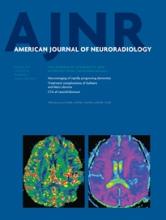Research ArticleNeurointervention
Open Access
Mind the Gap: Impact of Computational Fluid Dynamics Solution Strategy on Prediction of Intracranial Aneurysm Hemodynamics and Rupture Status Indicators
K. Valen-Sendstad and D.A. Steinman
American Journal of Neuroradiology March 2014, 35 (3) 536-543; DOI: https://doi.org/10.3174/ajnr.A3793
K. Valen-Sendstad
aFrom the Biomedical Simulation Lab (K.V.-S., D.A.S.), Department of Mechanical and Industrial Engineering, University of Toronto, Toronto, Canada
bCenter for Biomedical Computing (K.V.-S.), Simula Research Laboratory, Lysaker, Norway.
D.A. Steinman
aFrom the Biomedical Simulation Lab (K.V.-S., D.A.S.), Department of Mechanical and Industrial Engineering, University of Toronto, Toronto, Canada

REFERENCES
- 1.↵
- 2.↵
- Xiang J,
- Natarajan SK,
- Tremmel M,
- et al
- 3.↵
- Cebral JR,
- Mut F,
- Weir J,
- et al
- 4.↵
- Miura Y,
- Ishida F,
- Umeda Y,
- et al
- 5.↵
- Kallmes DF
- 6.↵
- Cebral JR,
- Meng H
- 7.↵
- Robertson AM,
- Watton PN
- 8.↵
- Hodis S,
- Uthamaraj S,
- Smith AL,
- et al
- 9.↵
Anysys Fluent 14.0: User's Guide. Canonsburg, Pennsylvania: Ansys Inc; 2011:p. 1317
- 10.↵
CCM Tutorials, Star-CD 4.02. Melville, NY: CD-adapco; 2006:p. 10–18
- 11.↵
- Cebral JR,
- Mut F,
- Raschi M,
- et al
- 12.↵
- Steinman DA
- 13.↵
- Fiorella D,
- Sadasivan C,
- Woo HH,
- et al
- 14.↵
- Cebral JR,
- Mut F,
- Weir J,
- et al
- 15.↵
- Baek H,
- Jayaraman MV,
- Richardson PD,
- et al
- 16.↵
- Ford MD,
- Piomelli U
- 17.↵
- 18.↵
- 19.↵
- Ferguson GG
- 20.↵
- Steinman DA,
- Hoi Y,
- Fahy P,
- et al
- 21.↵
- Logg A,
- Mardal KA,
- Wells G
- 22.↵
- Mahesh K,
- Constantinescu G,
- Moin P
- 23.↵
- 24.↵
- Krejza J,
- Mariak Z,
- Walecki J,
- et al
- 25.↵
- Alastruey J,
- Parker KH,
- Peiro J,
- et al
- 26.↵
- 27.↵
- Baharoglu MI,
- Lauric A,
- Gao BL,
- et al
- 28.↵
- Simkins TE,
- Stehbens WE
- 29.↵
- Yagi T,
- Sato A,
- Shinke M,
- et al
- 30.↵
- Prakash S,
- Ethier CR
- 31.↵
- 32.↵
- Xiang J,
- Tremmel M,
- Kolega J,
- et al
- 33.↵
- Torii R,
- Oshima M,
- Kobayashi T,
- et al
- 34.↵
- Geers AJ,
- Larrabide I,
- Radaelli AG,
- et al
- 35.↵
- Schneiders JJ,
- Marquering HA,
- Antiga L,
- et al
- 36.↵
- Kulcsár Z,
- Ugron A,
- Marosfoi M,
- et al
- 37.↵
- Takao H,
- Murayama Y,
- Otsuka S,
- et al
- 38.↵
- Baharoglu MI,
- Schirmer CM,
- Hoit DA,
- et al
- 39.↵
- 40.↵
- Brinjikji W,
- Cloft H,
- Lanzino G,
- et al
- 41.↵
- Antiga L,
- Steinman DA
In this issue
American Journal of Neuroradiology
Vol. 35, Issue 3
1 Mar 2014
Advertisement
K. Valen-Sendstad, D.A. Steinman
Mind the Gap: Impact of Computational Fluid Dynamics Solution Strategy on Prediction of Intracranial Aneurysm Hemodynamics and Rupture Status Indicators
American Journal of Neuroradiology Mar 2014, 35 (3) 536-543; DOI: 10.3174/ajnr.A3793
0 Responses
Jump to section
Related Articles
Cited By...
- Youre so vein, you probably think this models about you: opportunities and challenges for computational fluid dynamics in cerebral venous disease
- 4D-CT angiography versus 3D-rotational angiography as the imaging modality for computational fluid dynamics of cerebral aneurysms
- Towards the Clinical utility of CFD for assessment of intracranial aneurysm rupture - a systematic review and novel parameter-ranking tool
- Critical role of angiographic acquisition modality and reconstruction on morphometric and haemodynamic analysis of intracranial aneurysms
- Aneurysmal Parent Artery-Specific Inflow Conditions for Complete and Incomplete Circle of Willis Configurations
- Better Than Nothing: A Rational Approach for Minimizing the Impact of Outflow Strategy on Cerebrovascular Simulations
- Republished: Spontaneous thrombosis of a basilar tip aneurysm after ventriculoperitoneal shunting
- Hemodynamic Differences in Intracranial Aneurysms before and after Rupture
- Additional Value of Intra-Aneurysmal Hemodynamics in Discriminating Ruptured versus Unruptured Intracranial Aneurysms
- Spontaneous thrombosis of a basilar tip aneurysm after ventriculoperitoneal shunting
- Narrowing the Expertise Gap for Predicting Intracranial Aneurysm Hemodynamics: Impact of Solver Numerics versus Mesh and Time-Step Resolution
- Artery Length Sensitivity in Patient-Specific Cerebral Aneurysm Simulations
- The Computational Fluid Dynamics Rupture Challenge 2013--Phase I: Prediction of Rupture Status in Intracranial Aneurysms
- MR Imaging of Myeloperoxidase Activity in a Model of the Inflamed Aneurysm Wall
- Effects of Circle of Willis Anatomic Variations on Angiographic and Clinical Outcomes of Coiled Anterior Communicating Artery Aneurysms
- Resolving the Issue of Resolution
This article has not yet been cited by articles in journals that are participating in Crossref Cited-by Linking.
More in this TOC Section
Similar Articles
Advertisement











